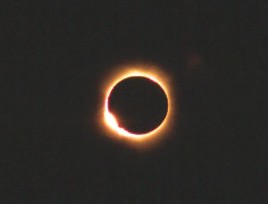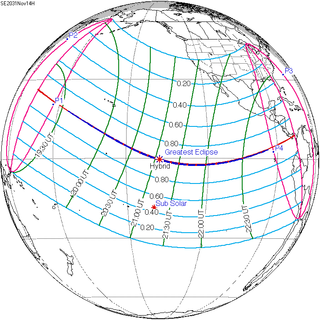
A total solar eclipse took place on December 4, 2002, with a magnitude of 1.0244. A solar eclipse occurs when the Moon passes between Earth and the Sun, thereby totally or partly obscuring the image of the Sun for a viewer on Earth. A total solar eclipse occurs when the Moon's apparent diameter is larger than the Sun's, blocking all direct sunlight, turning day into darkness. Totality occurs in a narrow path across Earth's surface, with the partial solar eclipse visible over a surrounding region thousands of kilometres wide. It was visible from a narrow corridor in southern Africa, the Indian Ocean and southern Australia. A partial eclipse was seen from the much broader path of the Moon's penumbra, including most of Africa and Australia. During the sunset after the eclipse many observers in Australia saw numerous and unusual forms of a green flash.

A total lunar eclipse occurred from 5:27 to 11:06 UTC on 21 December 2010, coinciding with the date of the Winter solstice in the Northern Hemisphere and Summer solstice in the Southern Hemisphere. It was visible in its entirety as a total lunar eclipse in North and South America, Iceland, Ireland, Britain and northern Scandinavia.

A total lunar eclipse took place on Friday, February 9, 1990, the first of two lunar eclipses in 1990.

A penumbral lunar eclipse took place on Sunday 30 December 2001, the last of three lunar eclipses in 2001. At maximum eclipse, 89.477% of the Moon's disc was partially shaded by the Earth, which caused a slight shadow gradient across its disc; this subtle effect may have been visible to careful observers. No part of the Moon was in complete shadow. The eclipse lasted 4 hours, 4 minutes and 17.7 seconds overall. This lunar eclipse followed the Annular Solar Eclipse on 14 December 2001.

A penumbral lunar eclipse took place on 24–25 May 2013, the second of three lunar eclipses in 2013. It was visually imperceptible due to the small entry into the penumbral shadow.

A total lunar eclipse took place on Thursday, December 30, 1982. A shallow total eclipse saw the Moon in relative darkness for 1 hour 3 seconds. The Moon was 18% of its diameter into the Earth's umbral shadow, and should have been significantly darkened. The partial eclipse lasted for 3 hours and 16 minutes in total. This was a supermoon since perigee was on the same day. It was also a blue moon, the second full moon of December for the eastern hemisphere where the previous full moon was on December 1. Since total lunar eclipses are also known as blood moons, this combination is known as a super blue blood moon.

A penumbral lunar eclipse took place on Wednesday, January 30, 1991, the first of four lunar eclipses in 1991.

A penumbral lunar eclipse took place on 30 November 2020. A penumbral lunar eclipse occurs at full moon when the Moon passes through Earth's penumbral shadow.
A penumbral lunar eclipse will take place on Monday, March 25, 2024. It will be visible to the naked eye as 95.57% of the Moon will be immersed in Earth's penumbral shadow.

A penumbral lunar eclipse will take place on Thursday, June 5, 2031.

A penumbral lunar eclipse will take place on May 7, 2031.

A penumbral lunar eclipse will take place on June 17, 2038. It is the second of 4 penumbral lunar eclipses, with the third eclipse on 16 July.
A total lunar eclipse took place on Sunday, January 30, 1972, the first of two lunar eclipses in 1972. The moon entered the Earth's penumbral shadow at 30 January 1972 08:03:12.5 UTC and exited at 30 January 1972 13:43:37.9 UTC. The moon entered the Earth's umbral shadow at 30 January 1972 09:11:38.4 UTC and exited at 30 January 1972 12:35:03.1 UTC. Totality lasted 34 minutes, 47.7 seconds, between 10:35:57.4 UTC and 11:10:45.1 UTC. The moon was 6.6 days before apogee, making it 1.6% smaller than average, only 0.2% larger than the July 1972's lunar eclipse.

A penumbral lunar eclipse took place on Sunday, July 15, 1973, the third of four lunar eclipses in 1973, the first was a penumbral lunar eclipse on Thursday, January 18, the second was a penumbral lunar eclipse on Friday, June 15, and the last being with a partial lunar eclipse on Monday, December 10.

An annular solar eclipse occurred on Sunday, June 21, 2020. An annular solar eclipse is a solar eclipse whose presentation looks like a ring, or annulus; it occurs when the Moon's apparent diameter is smaller than the Sun's, blocking most, but not all, of the Sun's light. In this instance, the Moon's apparent diameter was 0.6% smaller than the Sun's.

A total solar eclipse took place on Monday, December 14, 2020, when the Moon passed between Earth and the Sun, thereby totally or partly obscuring the image of the Sun for a viewer on Earth. Totality occurred in a narrow path across Earth's surface across parts of the South Pacific Ocean, southern South America, and the South Atlantic Ocean, when the Moon's apparent diameter was larger than the Sun's so all direct sunlight was blocked. The partial solar eclipse was visible over a surrounding region thousands of kilometres wide, including parts of the Pacific Ocean, South America, southwestern Africa, and the Atlantic Ocean. The Moon's apparent diameter was larger than average because the eclipse occurred only 1.8 days after perigee.

A total solar eclipse will occur on Friday, November 14, 2031. It is a hybrid event, with portions of its central path near sunrise and sunset as an annular eclipse. A solar eclipse occurs when the Moon passes between Earth and the Sun, thereby totally or partly obscuring the image of the Sun for a viewer on Earth. A total solar eclipse occurs when the Moon's apparent diameter is larger than the Sun's, blocking all direct sunlight, turning day into darkness. Totality occurs in a narrow path across Earth's surface, with the partial solar eclipse visible over a surrounding region thousands of kilometres wide.

An annular solar eclipse will occur on Wednesday, May 21, 2031. A solar eclipse occurs when the Moon passes between Earth and the Sun, thereby totally or partly obscuring the image of the Sun for a viewer on Earth. An annular solar eclipse occurs when the Moon's apparent diameter is smaller than the Sun's, blocking most of the Sun's light and causing the Sun to look like an annulus (ring). An annular eclipse appears as a partial eclipse over a region of the Earth thousands of kilometres wide. Occurring only 3.8 days before apogee, the Moon's apparent diameter will be smaller.

Saros cycle series 112 for lunar eclipses occurs at the moon's ascending node, 18 years 11 and 1/3 days. It contains 72 events, with 15 total eclipses, starting in 1364 and ending in 1616. Solar Saros 119 interleaves with this lunar Saros with an event occurring every 9 years 5 days alternating between each saros series.





































